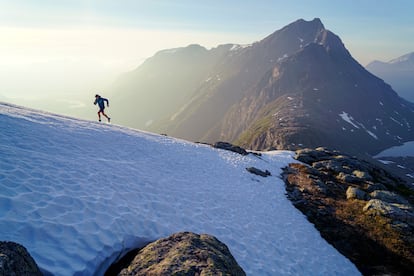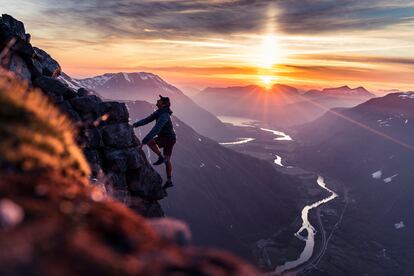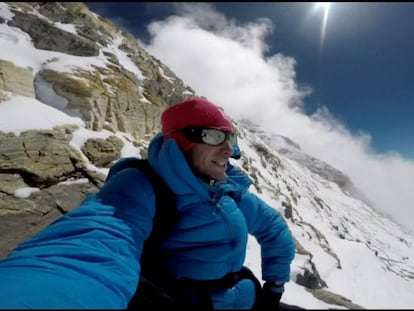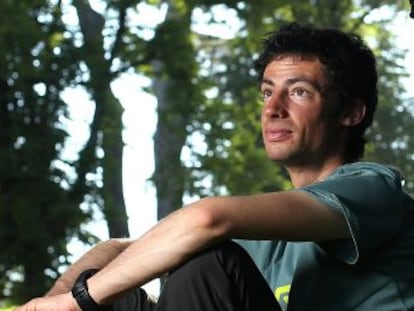Spanish ultrarunner Kilian Jornet takes on race against climate change
Known for his climbing feats, the elite athlete has started a foundation to protect mountain environments and pledged to restrict his own travel to reduce his carbon footprint


Kilian Jornet is known internationally for his feats as a mountain runner and climber. In 2017, for instance, he summited Mount Everest without supplemental oxygen not once but twice, just six days apart.
Jornet’s resume includes being considered the best ultramarathon runner in the world, smashing records in races such as the Ultra-Trail du Mont-Blanc and the Western States Endurance Run in California.
At age 32, this native of Sabadell, in Spain’s Catalonia region, has now decided to take on a very different sort of race against the clock: slowing down the degradation of the ecosystems that he knows so well.
This elite athlete has started his own foundation to defend the mountains from climate change, pollution and loss of biodiversity, but there is more: he has also made a personal decision to limit his own travel, and to stop after his trips have generated three tons of carbon dioxide a year, which he says represents " one international trip and one or two short-haul flights a year."
In a recent online conversation from his home in Norway, Jornet turned the camera to show the views from his window: a sublime mountain landscape dotted with peaks. Jornet, who grew up in a mountain lodge in the Pyrenees, explains that the mountain is his natural habitat, and that he cannot stand to be in cities for very long.
That is why he is saddened to admit that he, too, has played a role in the degradation of these natural environments: “My life in the last 10 years has been a disaster in environmental terms.”
Question. What does the mountain represent for Kilian Jornet?
Answer. It is my element, the place where I was born and raised, where I feel at ease. I can feel at home in the Pyrenees, in the Alps, in the Himalayas.... but in a city or a large village, I’m going to feel really stressed out.
Q. Is it possible to pay attention to the mountains when you are competing?
A. Not during the race, evidently. But the year that I competed the most I had around 50 races, which means 50 mornings out of 365 days. The rest of the time I am on the mountain, training without the stress of competition, and that’s when you enjoy it.
Q. What is the most fascinating aspect of these natural spaces?
A. Their variety. It’s surprising how different they can be. It’s impossible to compare the highest part of Khumbu in Nepal with the rocky towers of Monument Valley in the United States, or with the fjords and mountain faces here in Norway, or with any great glacier region of Greenland. They are completely different areas, but then again the mountain I have before me also changes from day to day. Now it’s all yellow, but in the winter there will be days when it is icy, and other days when it will be framed by northern lights. The fascinating thing about the mountain is how it changes, how it adapts.

Q. Why should we be concerned about the mountains?
A. There are three things that are a source of concern. One is the effects of climate change, which can be clearly seen in the glaciers, which are getting smaller or disappearing entirely. Besides the fact that glaciers are very pretty, there are relevant consequences such as rock destabilization and the transformation of ecosystems, and with them, of biodiversity. Then there is pollution. Here in Norway, I am lucky to be able to go running and drink from any river or lake without care. But there are many regions of the world, even mountain regions, where the water is polluted. And then there is the great challenge of the way man interacts with nature and what the tourism model and lifestyle model is in those mountain regions.
Q. What have you seen in the mountains that has pained you the most?
A. It is shocking when you go to a basecamp out of season, in the summer or the fall [because everyone goes in the spring], and find trash everywhere. But also when you are climbing a mountain in the Pyrenees and you see some kids on snowmobiles chasing down chamois.
Q. Taking a plane to reach the mountains of the world also generates emissions that contribute to climate change. How do you deal with this contradiction?
A. Just like with all other contradictions: they hurt and you need to find a balance. In recent years I have tried to reduce the number of trips that I take, and now I have decided not to travel any more than whatever generates three tons of carbon dioxide a year, which basically means one international trip and one or two short-haul flights a year.
Q. That makes some mountains out of reach.
A. It’s the commitment that I’ve made and I want to honor it; my sponsors have to accept it. In the end, it’s about deciding which competitions and projects are so important to me as to warrant travel. If it’s about training at a training camp, I can do that by racing near my house. And I can find other travel alternatives such as the train.
Q. A commitment like that must change the year’s planning quite significantly.
A. Yes, quite a lot. But we need to think about the model being followed in sports. These days, it’s all about taking a relatively stable group of people and moving them from place to place to do the same thing. I don’t know. Couldn’t it be a more local model that saves the trips for the finals? I think the time has come to discuss the future model that will make sports more sustainable.

Q. Is that why you created the Kilian Jornet Foundation to preserve the mountain environment?
A. I had been taking individual action for years, either through other associations or by trying to raise awareness among my followers on social media. But the birth of my daughter [in 2019] perhaps made me feel the urgency more intensely, and I asked myself what would be the best way to use whatever weight I might have. And I realized that maybe the most useful way was by creating a foundation.
Q. Is the retreat of ice from the mountains a warning sign that we are ignoring?
A. Around 40% of glaciers are already lost, and we will not be able to recover them, but 60% can still be saved. I am generally an optimistic person. We need to accept that there are going to be changes, but there is no need to be resigned, we must fight to revert the situation. I think that my daughter and her generation will enjoy the snow and the glaciers in a different way, but they will still be able to.
Q. For someone who grew up in the Pyrenees, at a mountain lodge where your father was the watchman, how do you feel about the fact that the glaciers there are utterly condemned?
A. It’s sad, it’s sad, because they are beautiful, and because they have a role to play. It’s sad to know that it is also my fault. My family raised me with this kind of awareness, but my life in the last 10 years has been a disaster in environmental terms. Why do we always wait so long? We need to look at the mistakes that we’ve made, but not just that, also work to revert them.
Q. Are people looking above all for a life of comfort, regardless of the impact?
A. Yes, we want comfort, but we are also creatures of habit [at this point in the interview, his daughter’s smiling face shows up on the screen]. I don’t think that taking a different form of transportation is going to be less comfortable. Or like now, we are doing the interview like this, and it’s also comfortable. I think it’s not so much about comfort as about a change of habits.
English version by Susana Urra.
Tu suscripción se está usando en otro dispositivo
¿Quieres añadir otro usuario a tu suscripción?
Si continúas leyendo en este dispositivo, no se podrá leer en el otro.
FlechaTu suscripción se está usando en otro dispositivo y solo puedes acceder a EL PAÍS desde un dispositivo a la vez.
Si quieres compartir tu cuenta, cambia tu suscripción a la modalidad Premium, así podrás añadir otro usuario. Cada uno accederá con su propia cuenta de email, lo que os permitirá personalizar vuestra experiencia en EL PAÍS.
¿Tienes una suscripción de empresa? Accede aquí para contratar más cuentas.
En el caso de no saber quién está usando tu cuenta, te recomendamos cambiar tu contraseña aquí.
Si decides continuar compartiendo tu cuenta, este mensaje se mostrará en tu dispositivo y en el de la otra persona que está usando tu cuenta de forma indefinida, afectando a tu experiencia de lectura. Puedes consultar aquí los términos y condiciones de la suscripción digital.
More information
Últimas noticias
Most viewed
- Sinaloa Cartel war is taking its toll on Los Chapitos
- Oona Chaplin: ‘I told James Cameron that I was living in a treehouse and starting a permaculture project with a friend’
- Reinhard Genzel, Nobel laureate in physics: ‘One-minute videos will never give you the truth’
- Why the price of coffee has skyrocketed: from Brazilian plantations to specialty coffee houses
- Silver prices are going crazy: This is what’s fueling the rally










































